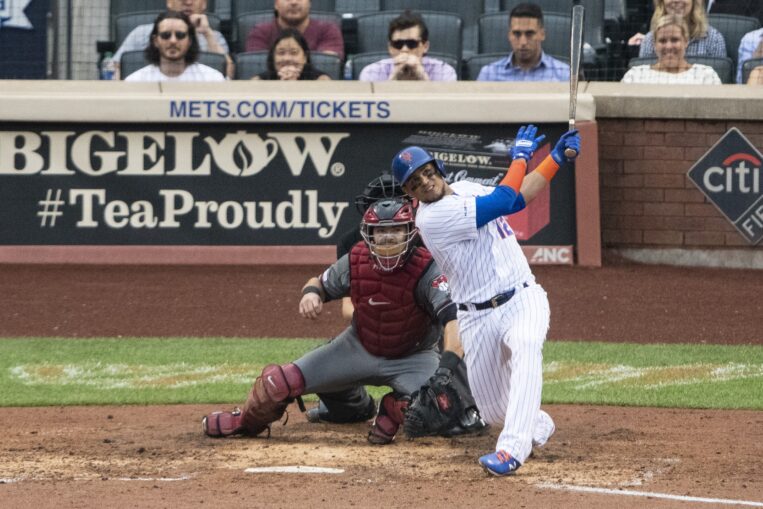
Most of the recent news cycle concerning the New York Mets has revolved around Carlos Beltran being named the club’s next manager. However, there were some other moves made by the front office that’ll have an impact on the upcoming offseason.
One of those included New York not picking up the $9.5 million club option on outfielder Juan Lagares, making him a free agent. He’ll now be forced out into the open market, trying to find a new home for the first time in his professional career.
This move made all the sense in the world from a logistical standpoint — $9.5 million is a lot of money for a player that is mostly utilized as a pinch-runner/defensive replacement. But on the emotional side of things, it’s tough solely for the fact that he’s been with the organization for such a long time.
Lagares was the longest tenured Met prior to his official departure, a 2014 Gold Glove winner, and part of the 2015 National League championship squad. It’s unfortunate that certain parts of his game didn’t continue progressing once he agreed to the four-year, $23.03 million extension he signed.
The Offensive Progression Didn’t Happen
News of Lagares and the Mets agreeing to an extension happened on the eve of Opening Day back in 2015, and at the time, it seemed like a worthy decision to make. He was about to enter his age-26 campaign, was fresh off winning that Gold Glove award, and while his offense was nothing too eye-popping (.633 OPS in ’13, .703 in ’14), it was trending in the right direction.
When looking at his overall offensive value, Lagares’ wRC+ improved from the 75 mark he posted as a rookie to 101 in his second season. Both of those campaigns saw him post an fWAR of at least 2.3, with a career-high mark of 2.9 coming in 2014.
He had shown the value of having his glove out in center field for a club built around elite starting pitching, so much so that league-average offense would be perfectly acceptable. Of the five seasons that followed after signing that extension, Lagares accumulated 150-plus plate appearances four times. His single-season wRC+ never finished higher than 85, with the 60 wRC+ he ended up with in 2019 being a career-worst mark.
A New Swing Didn’t Bring Better Results
The one year during this time period where he didn’t accumulate at least 150 plate appearances happened in 2018. He stepped into the batter’s box just 64 times before his season prematurely ended due to injury. While there was a lack of power in this small sample, his overall production looked great — Lagares posted a 111 wRC+ with a .339/.375/.390 line.
At first blush, it would’ve been easy to think that these promising results came from the effort he put into changing his swing in order to get ball up in the air more often. A quick peek at his peripheral stats from this particular season didn’t show much promise for it being sustainable. Lagares had a super-high .392 BABIP despite a higher soft-hit rate (25.5%) than hard-hit rate (23.5%). That was paired with an also-very-high 56.0% ground-ball rate, a 22.0% fly-ball rate, and a 18.2% infield-fly rate.
Any good feelings and momentum that he had moving into this past season was gone in quite a hurry, too. Through the end of June (155 plate appearances), the outfielder limped to a .179/.247/.257 triple slash, which sussed out to a 35 wRC+.
Defense Started to Slip
While most of his tenure with the Mets included above-average defense according to advanced metrics, the two-year span between 2013 and 2014 was on another level for Lagares. He combined for 52 Defensive Runs Saved, which was second to only Andrelton Simmons (69) when looking at players with at least 1,000 innings logged in the field. His 20.0 UZR/150 rating was also the best in baseball during this time.
The 30-year-old had some ups and downs in the years that followed because of injuries and whatnot, but he again asserted himself as a top-tier defender as recently as 2017. In just 566.2 innings, he put together 15 DRS with a UZR/150 of 22.8 — both of which were elite marks.
Advanced metrics weren’t nearly as kind to him this year as in recent years, though. For the first time in his career, Lagares’ DRS contribution was on the negative side of zero (-2), as was his UZR/150 (-6.1).
Career-low levels of offensive production combined with career-low levels of defensive production isn’t a good combination. Especially since he was due to earn his highest yearly salary as a big leaguer if the option was exercised.
Lagares’ 2019 From a Historical Perspective
Something that kept sticking out at me while taking a deeper look at Lagares’ season and career with the Mets was that 60 wRC+ from this past year. It’s obviously a very low number, but I was curious as to exactly how low it was.
Among hitters with at least 250 plate appearances, it was the 10th-lowest wRC+ in baseball. But when looking at it from a Mets-centric perspective, it’s even worse. Using the same stipulations, it was not only the second-worst mark in franchise history this decade, but also tied for the third-lowest mark for any Mets hitter since the turn of the century.
Woof.
And if he didn’t pick things up from July 1st to the end of the season (90 wRC+ over his final 130 plate appearances), this would’ve been a much different conversation. Lagares didn’t finish his Mets career on the highest of notes, but he did give us plenty of things to cheer about over the years.
It’s unfortunate that this particular transaction didn’t pan out how New York was likely envisioning it to, but this investment was at least a minor one in the grand scheme of things for an MLB organization. Now, the Mets have a little more flexibility to (hopefully) spend elsewhere with regard to areas of concern on the roster.















